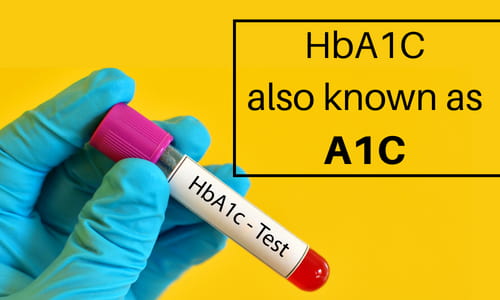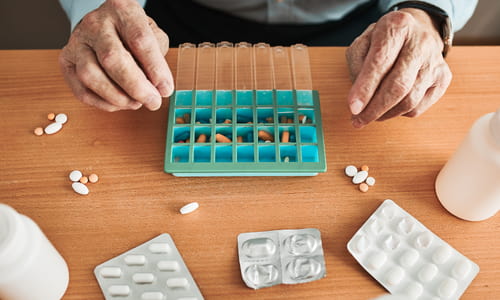Normal A1C Levels for Seniors
“Normal A1C Levels for Seniors” was written by Karina Herrera & edited/reviewed by Aly Bouzek, MS, RDN. Karina is a dietetic intern at Oregon Health and Science University.
If you are here to learn about normal A1C levels for seniors, then you’re in the right place!
We’ll go through the significance of the A1C test and how frequently it needs to be performed. We will examine normal A1C readings in seniors and discuss how crucial it is to maintain a healthy lifestyle.
Additionally, we will talk about how to manage your diabetes and how to lower your A1C through medication, diet, and exercise.
What is A1C?

A1C, also known as hemoglobin A1C or HbA1C, is a blood test that looks at average blood sugar levels over 3 months.
Your A1C is used to diagnose and help manage prediabetes, type 1 diabetes, and type 2 diabetes.
The results of the A1C test can help lead to the long-term management of diabetes.
A1C results can also be a crucial component of monitoring long-term glycemic control.
Diabetes Prevalence
In the United States, more than 29% of adults aged 65 years and older have diabetes (this accounts for those diagnosed with diabetes and those undiagnosed).
According to the Centers for Disease Control and Prevention (CDC), diabetes is the 7th leading cause of death.
Normal A1C Levels for Seniors
A1C levels for older adults can either be viewed as an A1C percentage or as a Fasting Plasma Glucose (FPG) range. The FPG test evaluates blood sugar after you haven’t eaten anything for 8 hours or more.
The table below is a helpful reference and shows the comparison between the two test results. As you can see, diabetes is diagnosed if A1C percentage is 6.5% or higher or if the Fasting Plasma Glucose is 126 mg/dL or higher.
| Test Results | A1C (%) | Fasting Plasma Glucose (mg/dL) |
| Normal | Less than 5.7% | Less than 100 mg/dL |
| Prediabetes | 5.7% to 6.4% | 100 to 125 mg/dL |
| Diabetes | 6.5% or higher | 126 mg/dL or higher |
What About Prediabetes in Seniors?
This is a great question. If you’ve recently been diagnosed with prediabetes, and you’re 65 years old or older, do you need to worry about the shift to diabetes?
The newest CDC study (published in April 2022) looked at almost 50,200 patients that were at least 65 years old and had been diagnosed with prediabetes. Over 8 years, only 5.3% of the patients progressed from prediabetes to diabetes annually. (1)
Another recent study of more than 3,400 seniors showed that over 6.5 years, less than 12% of them progressed from prediabetes to diabetes. (2)
Getting a prediabetes label can have you feeling worried, anxious, and vulnerable.
However, did you know that it’s common for seniors to have slightly higher blood sugar levels? This is because your body makes less insulin and it doesn’t process it as well as when you’re younger.
What does this mean for you? Well, it means that if you get a prediabetes diagnosis, it’s not inevitable that you’ll get diabetes. It is still important to eat nutritious foods, incorporate exercise a few times a week, and stay hydrated.
Note that this is not medical advice and you need to talk with your doctor if you have any questions.
Understanding Normal A1C Levels for Seniors
Let’s look at the importance of functional status in seniors to better understand A1C levels.
Functional Status
A senior’s functional status is a reliable indicator of their capacity to complete daily tasks, care for themselves, and control their diabetes. Independence and quality of life are so important as we age.
Basic Activities of Daily Life and Instrumental Activities of Daily life help to measure functional status. The factors mentioned below can help determine if an individual is able to manage their own A1C levels or if they need further assistance.
Basic Activities of Daily Life:
- Dressing
- Bathing
- Grooming
- Eating
- Transferring
- Toileting

Instrumental Activities of Daily Life:
- Transportation
- Housework
- Shopping
- Cooking
- Managing finances
- Managing medications
Below, we can see how the functional status of seniors and A1C percentage goals are recommended by the International Diabetes Federation (IDF). (3)
| Functional Status | A1C Goal (%) |
| Can function independently | 7 – 7.5% |
| Cannot function independently, may be frail, may have dementia | 7 – 8% |
Blood Sugar Targets
Knowing how your blood sugar level when you self-monitor at home is crucial. This can help you avoid becoming hypoglycemic (low blood sugar) or hyperglycemic (high blood sugar).
The device that you use will show you your blood sugar level at the moment of testing. This is called your Estimated Average Blood Sugar (eAG).
It’s helpful to know if your blood sugar level is near your target A1C. For example, if your A1C goal is 6%, then you’ll want your device to show an average reading of 126 mg/dL (7 mmol/L) or less.
| A1C (%) | Estimated Average Blood Sugar (mg/dL) |
| 6% | 126 mg/dL (7 mmol/L) |
| 7% | 154 mg/dL (8.6 mmol/L) |
| 8% | 183 mg/dL (10.2 mmol/L) |
| 9% | 212 mg/dL (11.8 mmol/L) |
| 10% | 240 mg/dL (13.4 mmol/L) |
| 11% | 269 mg/dL (14.9 mmol/L) |
| 12% | 298 mg/dL (16.5 mmol/L) |
Check out our Easy A1C Conversion Chart article for more information!
Complications
There is a strong relationship between high A1C readings and the risk of developing diabetes-related complications. A diabetes diagnosis increases (4):
- Depression
- Hearing loss
- Dementia
- Vision loss
- Urinary incontinence
- Fall risk
- Functional limitations
Living Environment
Your living environment may be playing a role in managing your diabetes. Take a look below to see how living situations and personal characteristics can impact your diabetes care.
For example, if you are living in a community environment (outside of a nursing home) and can function independently, then you may be given a more intricate diabetes regimen.
This can impact your diabetes if you are unable to follow the regimen or if it is too complex for you to manage. (3)
Another example is if you are living in a nursing home and you cannot function independently, then you will have to rely on staff and family members to time your meals and prepare meals that support your diabetes diagnosis. (3)
Being unaware of what meals you will be served and when they will arrive may put you at higher risk of diabetes mismanagement.
Managing Normal A1C Levels for Seniors
When regulating A1C, there are many important elements to take into account, including diet, exercise, and medication. Let’s find out how to better manage A1C for seniors.
Diet

Controlling what you eat and how often you eat are both important factors when it comes to diabetes management.
A diabetes diet for seniors should include balanced meals of lean protein, healthy fats, and high fiber carbohydrates.
Lean protein examples include poultry, tofu, eggs, nuts, nut butter, beans, legumes, and lentils.
Healthy fats include avocados, nuts and seeds, and olive oil. High fiber carbohydrates should be complex carbohydrates.
Those include beans, lentils, whole grains, fruits, and vegetables. Aim for 50% of your daily calories to come from these carbohydrates.
You’ll want to aim for 3 balanced meals a day and try to eat them at the same time each day. Take note of what foods you eat and your portion sizes in case they are needed by your doctor or registered dietitian.
Work with a registered dietitian and your doctor to create a plan based on your dietary choices and overall goals to manage your diabetes and your A1C.
If you’d like more information, check out our Healthy Eating Tips for seniors with diabetes.
Exercise
Exercise can help lower your blood sugar, maintain a healthy blood pressure, improve your balance and fall risk, and can help you sleep better.
According to the American Diabetes Association, it is recommended to get 150 minutes or more of moderate-intensity exercise each week. This could mean 30 minutes of exercise five times a week or 50 minutes of exercise three times a week.
However you decide to schedule your exercise, just make sure that it is a realistic goal for you!
Note: always speak with your doctor before starting an exercise routine.
Exercises for seniors with diabetes can look like:
- Yoga
- Walking
- Dancing
- Swimming
- Water aerobics
- Weight training
- Group workout activities
Medication
To help you manage your diabetes and A1C, your doctor may prescribe specific medication/s. Common medications for diabetes management in seniors are (5):
- Insulin Sensitizer Drugs (ISD), such as Metformin and thiazolidinediones, help to normalize blood sugar
- Insulin Releasing Drugs (IRD), such as sulfonylureas, help to lower your blood sugar
- Alpha Glucosidase Inhibitors (AGIs), help to manage and treat type 2 diabetes
- Incretin-based medications, such as DPP-4 inhibitors, mimic your gut hormones (incretins) that help to control your blood sugar and help with digestion
Conclusion: Normal A1C Levels for Seniors
Managing and maintaining a normal A1C can be difficult for seniors. Functional status, A1C goals, health complications, and living environment all contribute to seniors and how well their diabetes is managed.
Eating a carb-balanced diet that includes high fiber carbohydrates, lean proteins, and healthy fats, combined with regular exercise are great starting points for managing diabetes. Medications are also an option that doctors may turn to if additional help is needed.
Remember that a prediabetes diagnosis for seniors does not solidify a diabetes diagnosis. However, it is important to talk with your doctor to learn more about your individual situation and your health goals.

Excellent summary advice on normal HbA1C and insulin levels for older adults.
When it comes to maintaining one’s health, knowing how to measure A1C levels and determine ways to manage them are both vital actions. Thanks for sharing!